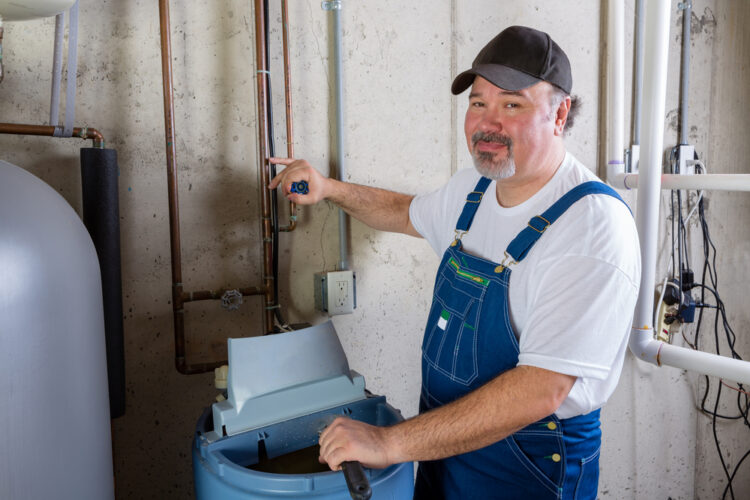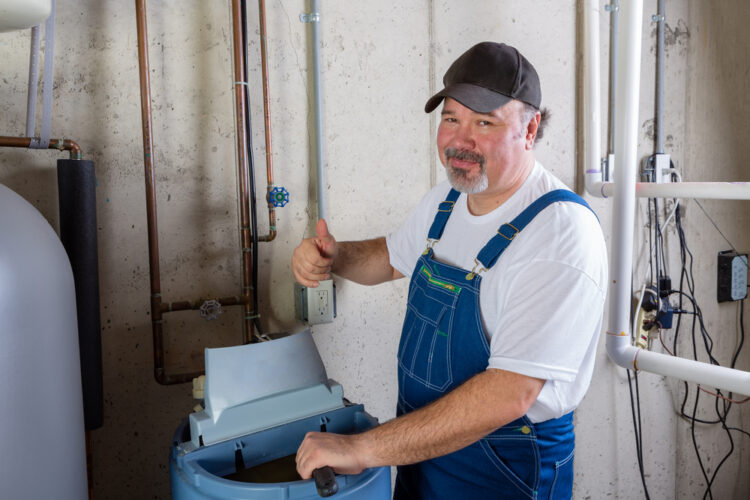If you’re using a water softener, you should know that proper drainage is essential because they dispose of the water directly. If you do so, it’ll harm the soil.
How can you properly deal with water softener discharge outside?
You can safely discharge the water using a dry well or a french drain. A dry well takes the water and discharges it deep into the soil. At the same time, a french drain disperses the discharge water over a large area. Both are legal and safe methods to drain the water that cause minimal damage.
If you have the time, continue reading because we have discussed both methods in detail, so you can pick one accordingly.
Let’s take a dive and see what’s up!
Can You Directly Discharge The Water Outside

Not! The salt-in-water softeners will kill grass and any tiny surface organisms. By doing this, you run the risk of severely damaging the environment.
Additionally, many states have strict laws and regulations. These discourage and often penalize homeowners if they find out about direct discharge.
You may be wondering if there are alternative uses for this discharge water. Well, it’s best to only opt for them after establishing a secure discharge system.
If you don’t want to drain, there are unique ways to utilize water softener discharge. But that’s a topic for later. Let’s investigate how you can safely drain water softener discharge.
How To Drain Water Softener Discharge Outside Properly

It’s crucial to ensure that drainage is safe and done correctly. This can be done in 2 ways: by making a dry well or a french drain.
For your ease, we’ve summarized the methods for you in the table below:
| Method | Skill level | Cost | Time |
| Dry Well | Medium to Hard | Around $200 for Dry well and other materials | One day |
| French Drain | Medium | It can cost up to $150 with piping and other materials | One day |
Does this seem complicated? You can always utilize the water softener instead of discharging it.
But as discharging is our priority, for now, let’s look at the detailed version of each method one by one-
The Dry Well Method
This is the most reliable method to discharge the water. Following this method, you’ll inject the water into the soil. This way, the topsoil of your yard will be safe and secure.
Needed Tools
For this method, you will need some tools. These include:
- Dry well
- Drill
- Pebbles and smooth stones
- Landscaping liner and
- Shovel
Now, let’s look at the steps-
Step 1: Dig The Hole To Fit The Dry Well
First, select a point that is 10 feet away from your house. Then dig a hole that is 4 feet deep and wide.
Remember to collect the soil you dig up. This will come in handy later when you need to cover the exposed pipes.
Step 2: Cover The Hole With A Liner
Now, use the landscaping liner to cover the hole. Remember to leave some overhang fabric. You can later trim this or cover it with stones.
Step 3: Set And Attach The Pipe
Get a PVC pipe and attach it to the main drainage from the machine. Add enough piping for it to reach the hole. Cap off any piping as you think necessary.
Make sure that the PVC pipes are capped off correctly. This will prevent leaks in the future.
Step 4: Install The Dry Well And Cover it With Stones
Install the dry well and make sure it’s leveled. Cover the surroundings with a one-inch depth of pebbles and stones.
Keep everything leveled using a level. This way, the water won’t flow in unpredictable ways.
Step 5: Cover With Soil
The last step is to cover the setup with soil. Opt for a light layer, not exceeding 1 foot. This will make it easy for you to dig out for repair and maintenance.
Now that we’re familiar with one method let’s see the alternative.
The French Drain Method
This method is more straightforward than the dry well. However, it works best if you have a big lawn, say more than half an acre. This will help disperse the discharge over a wide area.
The method has three steps. They include digging a trench, placing pipes, and covering it with soil.
Important Tools
You will need tools like:
- A shovel
- Landscaping fabric
- Pebbles
- PVC pipes
If you’ve got them, let’s continue!
Step 1: Making A Trench
First, you need to dig a trench. This trench should cover the perimeter of the foundation. It should measure about 1 foot wide and 20 inches deep.
Step 2: Lining And Installing The Pipes
Then line the trench with landscaping fabric and pebbles. Install the PVC drain pipes, making sure the holes are upwards. This spreads the discharge out evenly.
You can also buy perforated PVC pipes to do this more effectively. If you’re unsure which type to get, look at our options below. We have picked out the best ones for this job!
| Product 1 | |
| Product 2 |
After seeing them, let’s proceed with the remaining steps below.
Step 3: Cover And Level The Drain
All that remains now is to cover the pipes with more pebbles and stones. Add a layer of soil to conceal everything and level the place out.
With all of that mentioned, we’ve covered most aspects of safe outdoor water softener discharge. This brings us almost to the end!
FAQs
Question: How long can a water softener drain line be?
Answer: Ideally, the length of the drain line should be as short and low as possible. This means the piping for the drain shouldn’t be longer than 30 feet. You shouldn’t raise the pipe to a height higher than 8 feet. The optimal length is 20 feet, and the height of 4 feet.
Question: How much should a water softener discharge?
Answer: This will depend on the type and size of the water softener you have. Usually, it can discharge from 50 to 100 gallons of water.
Question: Should there be standing water in my water softener?
Answer: There shouldn’t be standing water in your water softener. If standing water is present, you need to check the water intake. You should see if there are any leaks for which the water tank is overfilling.
Conclusion
That wraps up our segment on water softener discharge outside. We hope our advice helps you set up a drainage that doesn’t harm the environment.
Do give the methods we mentioned a try! Finally, good luck with this home-improvement endeavor!